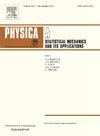加密货币与传统货币之间的风险溢出:基于神经网络分位数回归的分析
IF 2.8
3区 物理与天体物理
Q2 PHYSICS, MULTIDISCIPLINARY
Physica A: Statistical Mechanics and its Applications
Pub Date : 2025-03-31
DOI:10.1016/j.physa.2025.130560
引用次数: 0
摘要
加密货币在全球金融格局中日益突出,有必要重新评估它们与传统货币的相互作用。本文采用神经网络分位数回归(NNQR)框架描述了一个包含9种加密货币和11种传统货币的风险溢出网络。我们的研究结果表明,在COVID-19大流行等系统性危机期间,尽管全系统风险升级,但加密货币受传统货币的影响较小。加密货币风险敞口也主要在特殊时期出现在其市场内,这表现出很大程度的自主性。这种自主性使它们成为潜在的短期对冲工具,以防范政策引发的风险。此外,我们的研究还发现,与传统货币相比,加密货币的中间性中心性较低,但其接近中心性与传统货币相差不大。我们的研究发现,加元和印度卢比特别容易受到加密货币行业风险溢出效应的影响。然而,传统货币之间存在显著差异,这些差异对不同的加密货币产生了相当大的影响。这项研究为考虑使用加密货币进行市场外风险对冲策略的投资者提供了新的视角。本文章由计算机程序翻译,如有差异,请以英文原文为准。
Risk spillover between cryptocurrencies and traditional currencies: An analysis based on neural network quantile regression
The burgeoning prominence of cryptocurrencies within the global financial landscape necessitates a reevaluation of their interplay with conventional currencies. This paper employs a neural network quantile regression (NNQR) framework to delineate a risk spillover network encompassing nine cryptocurrencies and eleven traditional currencies. Our findings suggest that cryptocurrencies are less affected by traditional currencies during systemic crises such as the COVID-19 pandemic, despite the escalation of system-wide risk. Cryptocurrency exposures also come mainly within their markets during special times, which exhibits a significant degree of autonomy. This autonomy positions them as potential short-term hedges against policy-induced risks. Furthermore, our study also finds that cryptocurrencies have less betweenness centrality compared to traditional currencies, but their closeness centrality is not much different from traditional currencies. Our research identifies the Canadian dollar and the Indian rupee as being notably vulnerable to risk spillovers emanating from the cryptocurrency sector. However, there are significant differences in the traditional currencies that have a considerable impact on different cryptocurrencies. This study offers novel perspectives for investors considering the utilization of cryptocurrencies for out-of-market risk hedging strategies.
求助全文
通过发布文献求助,成功后即可免费获取论文全文。
去求助
来源期刊
CiteScore
7.20
自引率
9.10%
发文量
852
审稿时长
6.6 months
期刊介绍:
Physica A: Statistical Mechanics and its Applications
Recognized by the European Physical Society
Physica A publishes research in the field of statistical mechanics and its applications.
Statistical mechanics sets out to explain the behaviour of macroscopic systems by studying the statistical properties of their microscopic constituents.
Applications of the techniques of statistical mechanics are widespread, and include: applications to physical systems such as solids, liquids and gases; applications to chemical and biological systems (colloids, interfaces, complex fluids, polymers and biopolymers, cell physics); and other interdisciplinary applications to for instance biological, economical and sociological systems.

 求助内容:
求助内容: 应助结果提醒方式:
应助结果提醒方式:


